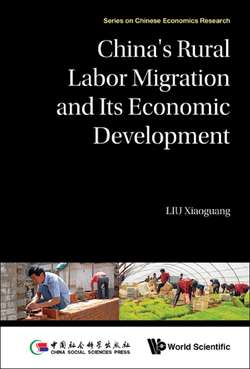China's Rural Labor Migration and Its Economic Development

Реклама. ООО «ЛитРес», ИНН: 7719571260.
Оглавление
Xiaoguang Liu. China's Rural Labor Migration and Its Economic Development
China’s Rural Labor Migration and Its Economic Development
Foreword
Preface
About the Author
About the Translator
Acknowledgments
Contents
Chapter 1. Introduction. I. Characteristics of China’s Economy
1. The riddle of China’s rising return on capital
2. The riddle of China’s rising savings rate
3. The riddle of “Okun’s Law” not being applicable to China
II. The Understanding of China’s Economy from the Perspective of the Transfer of Agricultural Labor
Chapter 2. Overview of the Transfer of Agricultural Labor. I. The Evolution of the Transfer of Agricultural Labor
II. Driving Factors for the Transfer of Agricultural Labor
1. Econometric model, regression variables and data description
(1) Key variables (i) The transfer of agricultural labor
(ii) Urban–rural income gap
(iii) Level of infrastructure
(iv) Total factor productivity
(v) Agricultural labor productivity
(2) Important variables
(i) Degree of openness
(ii) Proportion of state-owned enterprises
(iii) The level of public education expenditure
(iv) Scale and efficiency of financial development
(3) Other factors
2. The results of the empirical analysis
3. Brief conclusions
III. Technical Support for the Transfer of Agricultural Labor: The Revolution in Labor Productivity
1. The productivity of agricultural labor measured by added value
2. The productivity of agricultural labor measured by physical quantity
3. Brief comments
IV. Summary
Chapter 3. The Enigma of the Transfer of Agricultural Labor and the Rising Return on Capital. I. Introduction
II. Review and Discussion of the Literature
III. Theoretical Model
1. Model specification
2. Equilibrium analysis (1) Labor market equilibrium
(2) Mode of an increase in both the total number of migrant workers and their wages
(3) Analysis of the trend of change in the rate of return on capital
IV. Empirical Analysis
1. General measure of the technology spillover effect
2. China’s technology spillover effect and its rising return on capital
V. Recent Performance of China’s Return on Capital
VI. Conclusions
Chapter 4. Riddle of the Transfer of Agricultural Labor and the Rise of the Rate of Household Saving in China. I. Introduction
II. Review of the literature
III. Theoretical Model
1. Production
2. Preference
3. Equilibrium
(1) Capital accumulation and economic growth
(2) Rate of saving
IV. Analysis of the Economic Significance
V. Conclusions
Chapter 5. The Transfer of Agricultural Labor and the Okun Relationship in China. I. Introduction
II. Ideas of Analysis and Model Derivation. 1. Analysis of the ideas of the research
2. Theoretical model derivation
III. Analysis of the Generalized Okun Relationship in China
1. Indicator and measurement of the variable of the transfer of agricultural labor in China
2. Discussion on the indicator of China’s urban unemployment rate
3. Estimation of the Okun relationship model in China
IV. Test with Multinational Data
1. General formula of the generalized Okun model
2. Analysis of the subtype regression of sampling countries
V. Conclusions
Chapter 6. The Policy Implications of the Transfer of Agricultural Labor. I. Conclusions and Policy Recommendations
II. The Directions of Future Research
Appendix A: Proof of Lemma in Chapter 4. I. Proof of Lemma 3
II. Proof of Theorem 1
III. Proof of Theorem 2
Appendix B: Driving Factors and Spillover Effects of the Transfer of Agricultural Labor. I. Introduction
II. Theoretical Model
1. Model specification
(1) Balance
(3) Labor mobility spillover
(4) Free migration and technology spillover
Appendix C: Estimation of China’s Agricultural Labor Productivity. I. Introduction
II. Ideas of Estimation of Agricultural Labor Productivity
III. Estimation of Average Agricultural Labor Productivity
IV. Estimation of Agricultural Marginal Labor Productivity Measured by Value
1. Basic model of estimation of the function of agricultural production
2. Estimation of agricultural capital stock
3. Estimation of the marginal labor productivity of time series agricultural value added
4. Marginal labor productivity estimated by using the panel data of different provinces and regions
5. Summary of the results of the marginal labor productivity estimation by different methods
V. Estimation of Marginal Agricultural Labor Productivity Measured by Physical Quantity
1. Marginal labor productivity estimation by time series method
2. Marginal labor productivity estimation by the panel data method
3. Summary of the results of the marginal labor productivity estimation by different methods
VI. Conclusions
Bibliography
Index
Отрывок из книги
Series on Chinese Economics Research *
(ISSN: 2251-1644)
.....
VI. Conclusions
Chapter 4 Riddle of the Transfer of Agricultural Labor and the Rise of the Rate of Household Saving in China
.....